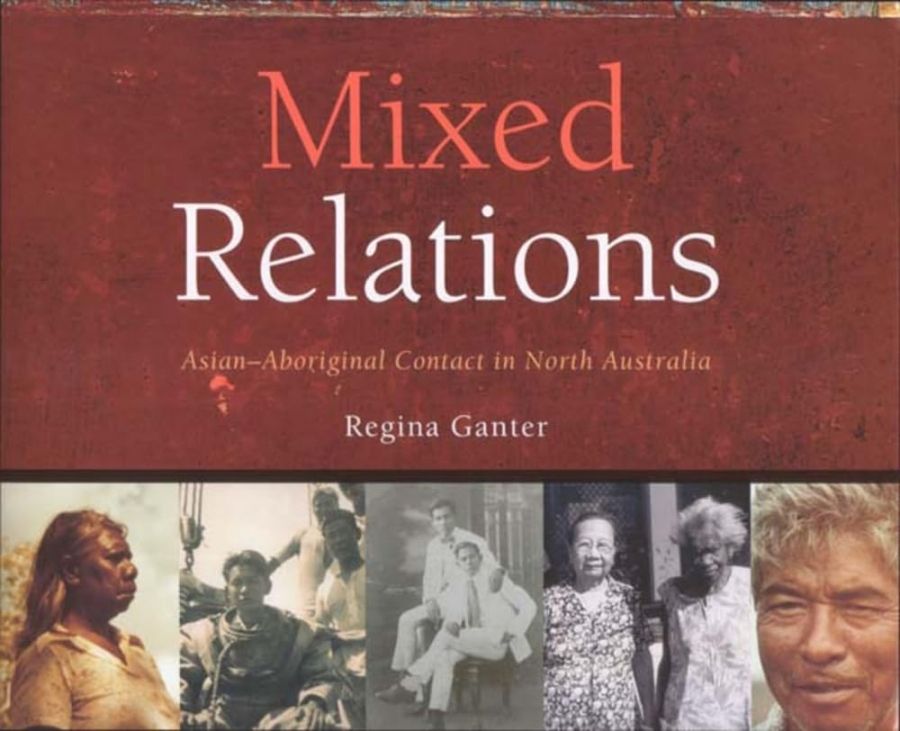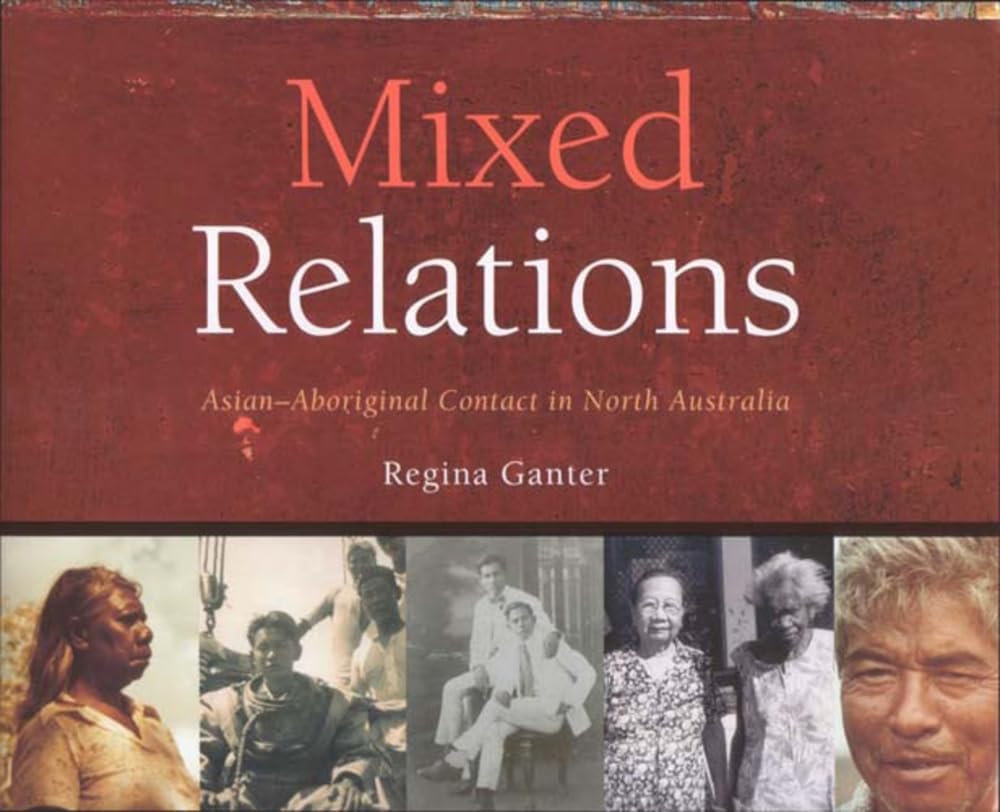
- Free Article: No
- Contents Category: Australian History
- Review Article: Yes
- Article Title: Imperfect execution
- Online Only: No
- Custom Highlight Text:
In recent years, ‘White Australia’ has become an episode in Australian history whose inception, imperfect execution and demise must be explained. Regina Ganter and her coauthors dwell on its spatial, as well as temporal, limits. ‘In the far northern townships, the dominant lived experience was not of a white Australia but of a polyethnic one.’ In northern coastal towns – particularly Broome, Wyndham, Darwin, Normanton, Cooktown and Cairns – people from Asia flourished and whites were marginal. Indeed, the Asian presence in Australia preceded that of whites. The first two chapters of this vividly illustrated book show a long and intimate association between Macassans and Yolngu (Arnhem Land Aborigines). Yolngu now recognise some citizens of Indonesia as ‘family’, referring to actual lines of descent.
- Book 1 Title: Mixed Relations
- Book 1 Subtitle: Histories and stories of Asian–Aboriginal contact in north Australia
- Book 1 Biblio: UWAP, $54.95 hb, 384 pp
- Book 1 Cover Small (400 x 600):

- Book 1 Cover (800 x 1200):

The term ‘polyethnic’, connoting both segregation and its subversion, lies at the heart of this book’s argument. In ‘the polyethnic north’, whites were an élite minority, ‘supported by the latent violence of the state apparatus’ and presiding over a society stratified by ethnicity. At the base stood ‘camp Aborigines serving as casual, seasonal and always unskilled labour’. The people in between whites and blacks were likely to be labelled in ethnic terms by officials and now, perhaps, by historians. However, Ganter warns against assuming that clear ‘ethnic disaggregation’ was achieved in the north. There are two aspects to her caution. One has to do with the difficulties of forging a consistent ethnic nomenclature. Some ethnic groups are more internally coherent than others (many kinds of Chinese), and they varied in their tendencies to intermarry with other ethnic groups. The book shows that ethnic labels are tendentious and that some are more tendentious than others.
As well, the concept ‘polyethnic’ presents an interpretative problem for historians: how plausible is the governmental fantasy that people’s behaviours could be ordered, by law and custom, into ethnic segregation? Were there not contrary imperatives from the government, such as Baldwin Spencer’s acceptance of established Asian–Aboriginal couples in 1912, Cecil Cook’s readiness in the 1930s to grant permission to ‘half-caste’ women who could find a respectable non-Aboriginal spouse, and the Administration’s unwillingness to segregate Darwin School? Whatever government officials wished, did people oblige them in their choice of friends, sexual partners, footy teammates and spouses? One of the book’s strongest themes is the popular subversion of officials’ ethnic tidiness. Julia Martinez, describing ‘ethnic policy and practice in Darwin’ up to 1939, writes that ‘the supposedly separate ethnic groups’ were in fact connected by the ‘hub’ of ‘Aboriginal–Asian people’ living at ‘Police Paddock’. Trade unions and congregations in Darwin tended to be ethnically inclusive. It was common for families in Broome to combine people of different ethnicities.
The subversive populace theme is only as persuasive as our understanding of its contrary: what authorities wished. The book could have said more about the variety of official government attitudes towards ethnic intermarriage and about the tensions between missionaries’ and officials’ notions of a ‘good’ union between men and women.
In Mixed Relations, the term ‘polyethnic’ refers to two different phenomena: the segregated coexistence of labelled ethnic groups in ‘society’, and the mingling of ethnicities within ‘families’. There is a tension between the nomination of ethnic diversity – in law, in much official discourse, and in this book’s historical narrative – and the book’s evocation of the hybridities that have resulted from people’s actual mixing (including their miscegenation, authorised or not).
Ganter is a champion of ‘polyethnicity’ in the latter sense. Multiply ethnic families ‘are the core of the coloured community that gave the far North its character’. Ganter knows many family trees that, when plotted over three or more generations and embracing the diverse spouse choices of all siblings, have many ‘ethnic lines of descent’, such as the descendants of the Jamaican trepanger Douglas Pitt (born in 1844). The pearling industry in Broome was an outstanding crucible of what she calls ‘polyethnic families’.
In her final chapter, Ganter is critical of the contemporary ‘binary’ language of identity insofar as it discourages recognition of ‘situational identity’ that is not consistently ‘Aboriginal’ because it is often as much ‘Asian’ (that is, Chinese, Filipino, Japanese, Macassan etc.) as ‘Aboriginal’. She would prefer the boundaries of ‘Aboriginality’ be ‘hazy’, and, implicitly, that ‘Aboriginal’ not be understood as a common heritage.
How did northern Australians come to have such fluid identities? Because the book uses the word ‘polyethnic’ in two ways, it cannot help but give two answers to that question. It would be a mistaken reading of Mixed Relations to suppose that the proliferation of ‘polyethnic families’ expresses the ethos of a ‘polyethnic society’, for the penultimate chapter is called ‘the decline of the polyethnic north’. What declined?
In one of Ganter’s usages, ‘polyethnic’ defines the social order in which whites, before World War II, attempted to feel secure in their minority management of the north’s social diversity. In her view, the governmental enforcement of polyethnicity began in response to white riots in Normanton against ‘coloureds’, particularly Chinese, in 1888. The principal logics of ‘polyethnic society’ in northern Australia were distinction and segregation, not ‘the harmonious blend of many cultures’. ‘The northern polyethnicity was underwritten by finely graded rules of etiquette that dictated where one lived, which school one attended, with whom one socialised, and even where one sat in the picture theatre.’ There was a ‘multitude of definable ethnic spaces’: neighbourhoods of towns, and even parts of a pearling boat. Governments had some responsibility for devising and enforcing these distinctions, especially in the confinement and close monitoring of Aborigines. The ‘enclaves’ of the polyethnic north were more than governmental impositions, however. They were also customary, a popularly internalised knowing of one’s place and a cultivated indifference to that which was nearby and alien (an attitude that some might call ‘tolerance’).
Ganter argues that, by making it militarily necessary to mobilise troops into the north, the war against Japan terminated this polyethnic society. The Japanese (or those of Japanese descent) were interned in the southern states during the war and then, in many cases, deported from Australia after Japan surrendered. Whites became the north’s majority, at first largely male – partly because of the evacuation of women and children – and under military authority. Worried about the loyalties and the infective presence of Aborigines, but requiring their labour, the authorities extended and intensified controls (and 1300 ‘part-Aborigines’ in the Northern Territory were shipped south). Among those who remained, various forms of war service (detailed by Ganter) renewed or instigated Aborigines’ and Chinese persons’ sense of entitlement to what other Australians enjoyed. The neglectful paternalism of the Aboriginal Protectors was displaced by the better-resourced and more egalitarian paternalism of the army.
Many of those Chinese and Japanese who returned to northern towns after the war could not find their houses and their enclaves; some places had been bombed, some demolished, some decayed, and many previous residents had been irrevocably dispersed. Assimilation, a social philosophy hatched in the 1930s and trialled (in effect) during the war, guided the reconstruction of the north. As white majority was entrenched, the racial minorities’ assimilation to a white southern version of the ‘Australian way of life’ became their only plausible future. By bringing ‘White Australia’ to the north, World War II caused ‘the decline of the polyethnic north’.
The term ‘polyethnic’, in this book, names not only a condition of intended segregation that ‘assimilation’ terminated sixty years ago but also a now-flourishing hybridity rooted in segregation’s evident failure. ‘Polyethnic’ is a concept that demands more thought.
If Mixed Relations does not realise its authors’ conceptual aims, it is nonetheless a splendid panorama of the north since the 1880s, assembling biographies, family histories and neighbourhood histories in a rich mosaic. Readers who know Australia only through its southern regions will feel increasing gratitude to Ganter and her coauthors, and will share the authors’ respect for the scores of people who revealed the details of their lineages.


Comments powered by CComment